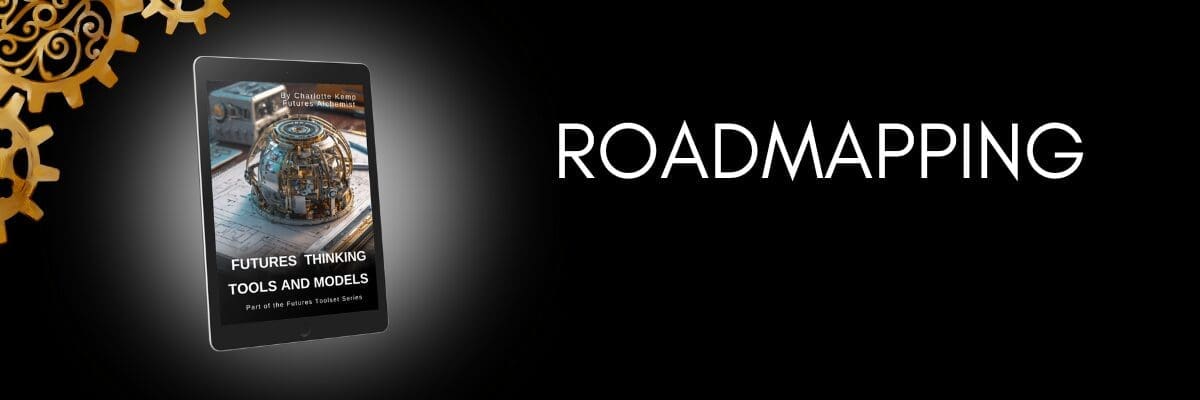
Introduction
Roadmapping is a strategic planning and foresight tool used to visually align long-term goals with the steps, technologies, and actions required to achieve them. It provides a structured timeline, or “roadmap”, linking present capabilities to future aspirations.
Unlike a project plan, which focuses on fixed deliverables and timelines, a roadmap shows how multiple streams of change converge over time to shape a preferred future. It helps teams see how decisions today enable or constrain future options.
The visual representation of this tool
A roadmap is typically represented as a layered timeline or multi-track visual, often drawn horizontally.
Common features include:
- Time axis (usually from left to right): near-term, mid-term, and long-term horizons.
- Layers or tracks: representing different dimensions—such as technology, products, markets, capabilities, or policy areas.
- Milestones and dependencies: key innovations, decision points, or enabling conditions plotted along the timeline.
- Convergence points: where different streams align to achieve a shared goal.
The visual resembles a journey map, showing not only where we are heading but also how the various routes interconnect along the way.
What it looks like
Using roadmapping usually involves collaborative workshops that unfold in four main phases:
- Clarify the vision or end-state — Define the strategic objectives or future scenario the organisation is aiming for (e.g., “Net Zero Factory by 2040” or “Next Generation Product Suite”).
- Identify key layers — Decide which categories or dimensions matter most (e.g., technology, customer needs, capabilities, partnerships, regulation).
- Plot the pathway — Teams map current status, transitional stages, and future goals along the timeline, noting dependencies, enablers, and critical milestones.
- Synthesize and communicate — The resulting roadmap is refined into a visual reference that guides strategy, investment, and innovation priorities.
In practice, a roadmap might cover 5–25 years, depending on the field (shorter for tech or product innovation, longer for infrastructure or sustainability).
Examples
- A classic example of roadmapping in action is Motorola’s Technology Roadmapping (TRM) approach, first developed in the late 1970s to align R&D investments with future market needs. This became one of the earliest formalised models, later adapted widely across industries.
- Another well-known case is the International Technology Roadmap for Semiconductors (ITRS)—a collaborative, global effort launched in 1992 by major semiconductor manufacturers. The roadmap helped coordinate global R&D priorities, ensuring that transistor miniaturisation and computing power advances stayed on track for decades (often referred to as “Moore’s Law in action”).
- In public policy, the UK’s Office for Science and the European Commission have both used roadmapping to plan research priorities in clean energy, AI, and biotechnology.
How and when it is used
Roadmapping is used when organisations or systems must navigate complex, interconnected developments over time, particularly when:
- Technological or social changes are rapid.
- Multiple stakeholders must coordinate their efforts.
- Long-term investment or innovation requires clear strategic direction.
Typical contexts include:
- Technology and innovation management (e.g., R&D, engineering, ICT).
- Corporate strategy and product portfolio planning.
- National foresight programmes and industry visioning.
- Education and skills planning (mapping future competencies).
- Sustainability transitions (aligning actions to long-term goals such as decarbonisation).
Roadmapping serves as both a planning instrument and a communication tool, enabling alignment between decision-makers, researchers, and implementers.
Examples of use
University of Cambridge’s Institute for Manufacturing (IfM) has pioneered participatory roadmapping, using it as a facilitation tool for multi-stakeholder dialogue—bringing together government, industry, and academia to co-design shared futures.
NASA uses roadmaps to coordinate complex systems development, from propulsion technologies to space exploration missions, over multi-decade timelines.
In education foresight, institutions have built “Learning Roadmaps” that connect the future of work, skills development, and curriculum redesign.
Food systems and climate action coalitions use roadmapping to plan transitions toward regenerative agriculture or circular economies, visualising the social and technical enablers needed at each stage.
Some organisations apply backcasting within a roadmap, starting with a future milestone (e.g., “2035 Circular Supply Chain”) and then working backwards to fill in the steps—blending both tools effectively.
Origin
The origins of roadmapping trace back to the technology management practices of the 1970s, particularly within Motorola, where it was formalised by Dr. Robert Galvin and his team as a way to integrate R&D, product development, and market strategy.
The concept was further developed in academic research during the 1980s and 1990s, notably by Robert Phaal, Clare Farrukh, and David Probert at the University of Cambridge’s Institute for Manufacturing (IfM). Their work transformed roadmapping from a corporate planning tool into a strategic foresight methodology applicable across industries and public policy.




